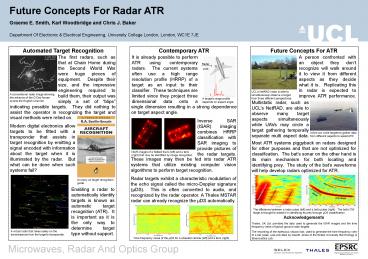Future Concepts For Radar ATR - PowerPoint PPT Presentation
1 / 1
Title:
Future Concepts For Radar ATR
Description:
The bat's CW stage is thought to assist it in identifying its prey through ... ISAR images of a flatbed truck (left) and a tank (right) that may be identified ... – PowerPoint PPT presentation
Number of Views:77
Avg rating:3.0/5.0
Title: Future Concepts For Radar ATR
1
Future Concepts For Radar ATR
Graeme E. Smith, Karl Woodbridge and Chris J.
Baker
Department Of Electronic Electrical
Engineering, University College London, London,
WC1E 7JE
Automated Target Recognition
Contemporary ATR
Future Concepts For ATR
The first radars, such as that at Chain Home
during the Second World War were huge pieces of
equipment. Despite their size, and the
impressive engineering required to build them,
their output was simply a set of blips
It is already possible to perform ATR using
contemporary radars. The current systems often
use a high range resolution profile (HRRP) of a
target as an input to their classifier. These
techniques are limited since they project three
dimensional data onto a
A person confronted with an object they dont
recognize will walk around it to view it from
different aspects as they decide what it is.
Replicating this in radar is expected to improve
ATR performance.
Multistatic radar, such as UCLs NetRAD, are able
to observe many target aspects simultaneously
while UAVs may circle a target gathering
temporally separate multi aspect data.
indicating possible targets. They did nothing to
assist the operator in recognizing the target and
single dimension resulting in a strong dependence
on target aspect angle.
Inverse SAR (ISAR) imaging combines HRRP
classification with SAR imaging to provide
pictures of the radar targets.
visual methods were relied on. Modern digital
electronics allow targets to be fitted with a
transponder that assists in target recognition by
emitting a signal encoded with information about
the target when it is illuminated by the radar.
But what can be done when such systems fail?
Most ATR systems piggyback on radars designed for
other purposes and that are not optimized for
classification. The bats sonar on the other
hand is its main mechanism for both locating and
identifying prey. The study of the bats
waveforms will help develop radars optimized for
ATR.
These images may then be fed into radar ATR
systems that utilize existing computer vision
algorithms to perform target recognition. Radar
targets exhibit a characteristic modulation of
the echo signal called the micro-Doppler
signature (µDS). This is often converted to
audio, and recognized by the radar operator. A
Thales MSTAR radar can already recognize the µDS
automatically.
Enabling a radar to automatically identify
targets is known as automatic target recognition
(ATR). It is important as it is the only way to
determine target type without support.
Microwaves, Radar And Optics Group































